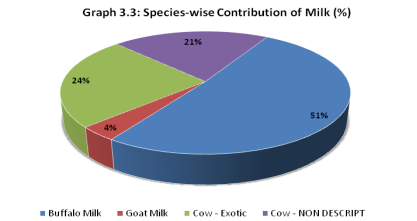Goat resources in India and its contribution in Indian economy
Goat, the poor man’s cows, fit in amicably to achieve the inter-dependent objectives of poverty alleviation, availability of food, creation of employment and growth in rural income. The livelihood security of an incredibly large number of farm families is linked to livestock. Majority of small and marginal farmers derive their livelihood from goats. India with 148 million goats is one of the largest goats owning country in the world and playing a significant role in livelihood and nutritional security as well as providing supplementary income to nearly 70 million farmers of over 5,00,000 remote villages. Goat meat production in the country has increased from 0.47 to 0.59 million tons during the last decade (2002 to 2011) with an annual growth rate of 2.4%.
Similarly, goat milk production in the country has also increased from 3.6 to 4.7 million tons during the same period with an annual growth rate of 2.6 %. The country stands first in goat milk production and is the second largest in goat meat in the world by sharing 29% & 12% production, respectively. Goat meat (Chevon) is most preferred and widely consumed meat in the country. Since ancient times goat milk has traditionally been known for its medicinal properties and has recently gained importance in human health due to its proximity to human milk for easy digestibility and it’s all round health promoting traits. The goat sector contributes 8.4 % to the India’s livestock GDP i.e. 38,590 crores through meat (Rs. 22,625 crores), milk (Rs. 9,564 crores), skin (Rs. 1491crores), manure (Rs. 1,535 crores) and others Rs 3,360 crores. The goat husbandry also generates about 4.2% rural employment to the small, marginal farmers and landless laborers.
Women are also benefited by goat rearing being the main custodian in rural areas, especially in Bihar, Jharkhand, West Bengal, Rajasthan, NEH and many tribal regions of the country. In the recent years, commercial goat farms have emerged in different parts of the country providing substantial income to the progressive farmers.
Milk Production in India
Milk and milk products are the essential food items of human beings which provides sufficient nutritional supplements especially to the children. The milk production in the country was 17.0 million tonnes during 1950-51. A number of initiatives under taken by the government helped improving the productivity of milk over the period. A trend showing the increase in milk production over the past three decades is depicted in the. The analysis shows that during the 11th five year Plan (2007-08 to 2011-12), the average annual growth rate of milk production was 4.5%. As a result, the total Milk production during the period has increased from 107.9 million tonnes in 2007- 08 to 127.9 million tonnes in 20011-12. At the beginning of 12th five year Plan i.e. (2012-13), the total Milk production was 132.4 million tonnes. The milk production increased from 127.9 million tonnes in 2011-12 to 132.4 in 2012-13 registering a growth of 3.5%. Now during 2018-19, the total milk production of the country amounted to about 187 million metric tons.

A Graph shows the contribution of milk production by Cattle, Buffalo and Goat. The analysis shows nearly 51% of milk production is contributed by Buffalo followed by 24%, 21% and 4% for Cow Exotic/Crossbred, Cow Non-Descript and Goats respectively.
Since last decade goat milk contribution in total milk production is around 4%. It is due to low productivity and also authorities gave less priority to goats. It is highest in World.
The contribution of goat milk in India is steadily rising due to its demand during the times of viral disease out breaks after rainy season. Many researches claims that short chain fatty acids present in goat milk have antiviral and antibacterial properties.
Distribution of goats in India
UP and Rajasthan together contribute nearly 24% of goat population in India. Further, increasing trends of growth rates are seen in these areas. Conducive environment is one such factor.









